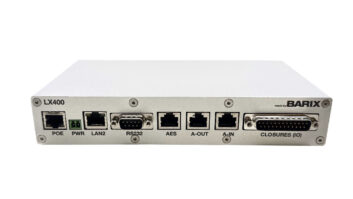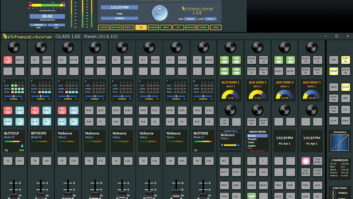LISBON, Portugal — Grupo Renascença Multimedia (Grupo Renascença), which covers Portugal with four FM radio services, recently wrapped a facility-wide upgrade in Lisbon that transitioned its on-air and production services to an IP contribution and distribution platform.

The project, at press time, represents what is believed to be the largest Dante-based AoIP distribution system in radio today, according to AEQ Director of Sales for Special Markets Peter Howarth.
FOUR NETWORKS
Comprised of four AoIP networks, the facility’s modernized production and broadcast architecture in addition features all-digital audio mixing consoles made by AEQ, which also served as the project’s design and systems integrator. This architecture significantly increased signal capacity — to the tune of four-and-a-half times the previous ceiling — and enhances redundancy, with two of the AoIP networks carrying the same complete mix of the facility’s broadcast services.

An AEQ Arena console in the Radio Renascença studio.
The decision to use AoIP networking simplifies the allocation of Grupo Renascença’s 15 broadcast studios among the company’s four broadcast services — Radio Renascença, RFM, SIM and Mega Hits. Using Dante’s uncompressed, multichannel digital media networking technology, Grupo Renascença’s AoIP infrastructure has increased the capacity and flexibility of this broadcaster’s internal signal management system.
“In our new infrastructure, any studio can be easily used by any of the four services, which significantly expands their management effectiveness,” said João Pereira, Grupo Renascença’s director of Technologies and Innovation. “If required, any of the broadcasting signals can be redirected between studios, with no impact on the broadcast itself.”
Grupo Renascença’s move to AoIP signal distribution specifically, and to a new facility in general, marks the company’s move into 21st century broadcasting.
“The constant structural changes that we had to make over time, which were essential to adapting to new demands, proved to be incompatible with remaining in our 18th century heritage building in downtown Lisbon,” explained Pereira.
“Although we had some digital mixers and a small switching matrix, all distribution was analog, with its inherent limitations. Our studios’ layout, spread across three floors, hampered our ability to manage the different broadcasting signals, as well as complicated user management.”
MODERN FACILITIES
This diagram shows a plan of Radio Renascença’s technical upgrade.
Click to Enlarge

The move to Grupo Renascença’s modern facility gave the company and its systems designer/integrator AEQ the chance to address all of these shortcomings. The result is a modern broadcast facility with room to grow in the years ahead.
In assigning AEQ to design and install its new Lisbon broadcast facility, Grupo Renascença set a number of stipulations. These included that all of the AEQ audio consoles be digital; that all signals generated or ending in the studios be transported between the studios and the Technical Control Center over IP; and that all studios had to be interconnected via a centralized infrastructure, to allow the use of any signal from any location.
AoIP technology was mandated to avoid the inflexibility associated with using multipair bundles and MADI cables, and to maximize fast, reliable routing between locations with a minimum of operator intervention.
Grupo Renascença’s many requirements explain why AEQ opted to use Dante, the AoIP technology developed by Audinate, to distribute the facility’s audio signals.
“With Dante, the system is entirely plug-and-play, with an emphasis on easy signal availability,” said Howarth. “If you need a signal, you just subscribe to it and you’ve got it on your console. As soon as you don’t, you just let it go and the previously used channel is now free. It’s very simple to use.”
In meeting Grupo Renascença’s facility requirements, AEQ had to be mindful that Portuguese radio broadcast studios typically use two or three audio consoles. The main console operated by the show host, while an auxiliary console used a guest or journalist in another studio. A third console is installed in the control room.
DETAILS

AEQ routers and Netbox 32 installed at Radio Renascença.
“Besides the new mixers, the Dante audio distribution system and the AEQ switch matrix, we have installed a new Telos System VX Engine hybrid telephone management system; renovated our IT infrastructure based in HP and Aruba technology; and replaced our telephone switchboard with an IP model by Astra/Ericsson,” said Pereira.
“We’ve also implemented a new automation system — Zetta from RCS — supported on a single SQL database that contributes to the flexibility of the studios.”
All of the signals to and from these studios, and 10 more, are routed through the TCC. Centralizing the production equipment normally found in individual studios has substantially reduced the amount of cabling required for the facility in Oporto, as has using Dante over AoIP rather than sending analog signals over dedicated wires.
AEQ also installed a TDM router within the TCC; specifically, the AEQ BC 2000D modular digital audio matrix. Offering up to 5000 x 5000 audio data channels, the BC 2000D provides the interconnection/routing hub for the four AoIP networks.
By choosing AEQ’s AoIP over Dante approach, Grupo Renascença was able to get its new Oporto facility on air relatively quickly; requiring less cabling and less labor to achieve this goal than would have been the case with other broadcast architectures.
“We’re talking tens, if not hundreds of thousands of yards in audio cable that we no longer have to use,” said Howarth. “We’d have been stuck making point-to-point connections for close to 3,000 channels in a TDM system, which would have added several weeks of integration work. Add Dante’s low latency and great audio quality, and one can see why the client was satisfied,” Howarth said.
“With this setup, we can easily integrate new sound sources in our infrastructure,” said Pereira. “Meanwhile, because our system of four AoIP networks includes a Dante primary network and a secondary network carrying the same programming, this provides us with true redundancy.”
Howarth believes that choosing digital production and Dante AoIP has proven to be a real problem-solver for Grupo Renascença. “The company’s engineers no longer have to work around the limitations of an aging analog infrastructure, and focus on the business of making great radio for all of Portugal.”












